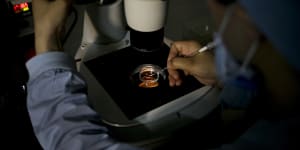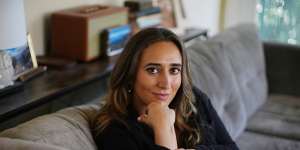Such rulings could have sweeping consequences for a huge number of would-be parents:in the United States,more than 2 per cent of all infants born are conceived using assisted reproductive technology,of which IVF is the most common. At least 12 million babies have been born globally using IVF since 1978,according to the National Committee for Monitoring Assisted Reproductive Technologies.

A medical staff member collects an egg on a laboratory dish for an in-vitro fertilisation procedure.AP
Couples who choose IVF are still in the minority of those trying to conceive. They tend to be wealthy – the cost of a single cycle of IVF is about $US23,474 ($36,000),according to Fertility IQ,an educational website about fertility. They are mostly in their mid- to late 30s or 40s,when the statistics for conceiving naturally are not in their favour:at age 35,there is a 15 per cent chance of conceiving naturally per month,according to the American College of Obstetricians and Gynecologists. At 40,that drops to 5 per cent.
Dr Alan Copperman,the CEO of RMA of New York,a fertility centre,is one of many doctors seeing more couples,who are well aware of the challenges of conceiving and carrying a healthy baby to full term,skip sex and go straight to IVF.
The challenges that couples cite vary widely. They may not “have the time to try naturally”,said Copperman,who is also a professor of obstetrics,gynecology and reproductive science at the Icahn School of Medicine at Mount Sinai in New York. “They want to use technology to achieve their reproductive goals,” he said.
The choice may also be an issue of logistics;couples may not be in the same place long enough to have sex during ovulation windows. “I’ve had a lot of patients who are working in consulting or have a business,and they travel a lot for work,” said Dr Denis Vaughan,a reproductive endocrinologist at Boston IVF. “They might tell me they’ve been trying for six months,but they’ve really only been together at the right time for two or three months of that time.”
‘We really wanted to have a second girl.’
Faith Hartley,35,who used IVF to guarantee the sex of their baby
Some couples are motivated by health and want to screen embryos for harmful genetic mutations that they may have or carry. Others want to use the procedure to choose the gender of their child.
Most insurance plans won’t cover IVF until after a heterosexual couple has tried to conceive naturally for at least a year if the woman is younger than 35,and for six months if she’s older. (Same-sex couples or women conceiving on their own are sometimes subject to different rules.)
That means people who choose IVF are either paying for the procedure out of pocket or fudging the number of months they’ve been trying to conceive naturally. (Insurance companies or doctors can’t prove what’s happening in the bedroom.)
IVF,however,is hardly guaranteed to be successful:the procedure still has a risk of miscarriage,though the likelihood is lower because the embryos have been genetically tested and only the most viable are typically implanted. And success rates can vary according to maternal age. According to the Centres for Disease Control and Prevention,women younger than 35 have an almost 50 per cent chance of having a live birth after one IVF cycle. For women older than 40 using their own eggs,that number drops to 7 per cent.
“The vast majority of people who are doing it are truly desperate and have a medical reason for doing it,” said Dr Tarun Jain,a professor of obstetrics and gynecology at Northwestern University. “It is a very challenging,time-consuming,physically and emotionally draining process,and a big financial burden if your insurance doesn’t cover it.”
‘Empowered and Relieved’
Sarafina El-Badry Nance,an astrophysicist at the University of California,Berkeley,found out at 23 that she carried a BRCA gene mutation,an inherited variant that significantly increases a woman’s chance of developing breast and ovarian cancer. Parents have a 50 per cent chance of passing it along to offspring.
“I met with a genetic counsellor after getting my test results,and we talked through what it meant,” said El-Badry Nance,who is now 30. “I learned about IVF and genetic testing on embryos and knew that was an option for me long before I was even thinking about having a baby.”

Sarafina El-Badry Nance,carries a gene mutation that significantly increases the chances of developing breast and ovarian cancer.The New York Times
Once her eggs were retrieved and tested for the mutation,she and her husband,Taylor Nielsen,31,decided to freeze embryos last summer that she will have implanted in the next few years when they are ready to have a child.
“In theory,once embryos are frozen,they can stay in that steady state indefinitely,without any known harm,” Jain said.
“I lost my grandmother to cancer,” El-Badry Nance said. “My dad was diagnosed at stage 4. The risk profile is so high for my family.”
“I mostly just feel empowered and relieved that we will set up our child for a healthy life,” she added.
The Ability to Choose

Faith Hartley and her two girls,Aspen (left) and Bardot,who was conceived using in vitro fertilisation.The New York Times
Faith Hartley,35,and her husband,Neil Robertson,49,conceived their first child quickly,in July of 2019. But for their second child,who was born in December 2022,they chose IVF so they could guarantee the gender. “We really wanted to have a second girl,” Hartley said.
They froze embryos in January 2022 and implanted one that March,successfully. (Most doctors recommend that a patient unfreezes whichever embryo is healthiest,but it is legal in the United States to select one based on its sex.)
Hartley,who lives in Los Angeles and works as a sleep consultant,said the procedure,which she and her husband paid for out of pocket,was the hardest thing she’s ever done,physically speaking. “The injections are brutal,” she said. She was so sore,she said,that “some days I could not get out of bed,” adding that the hormones impacted her mental state.
But in the end the couple feels it was worth it:“To get the sister thing for my girls,I would have done anything,” Hartley said. She added that in her social circles,going through IVF to choose the gender is “not unusual”,though the practice of gender selection is controversial. “I have multiple friends who have done it and are looking into doing it.”
Dr Lucky Sekhon,who also works at RMA of New York,the fertility clinic,noted that though preimplantation genetic testing of embryos is not perfect,it can ensure embryos have the right number of chromosomes,which reduces the odds of miscarriage.
Sekhon also believes that many couples should view IVF as a backup,not a first,option. Many clients,she said,come to her thinking they have little chance of conceiving naturally when they are actually in good health to do so. “Most of these women can still have very healthy babies,” she said.
An exception is someone like El-Badry Nance,who has the BRCA gene mutation. “They know something runs in their family,” said Sekhon,“and those are reasons to avoid getting pregnant naturally.”
Doctors agree that IVF is a numbers game,and the more frozen embryos you have to work with,the higher the chance of success since not all unfreeze or implant properly. Because of that,Sekhon believes most couples,if they can,should first try to conceive naturally before using frozen embryos.
“It’s much smarter to use your embryos when you really need to,” she said. “Isn’t it better to save them for a rainy day?”
But some couples disagree. As Hartley put it:“We have the science to do this. Let’s use it.”
This article originally appeared in.